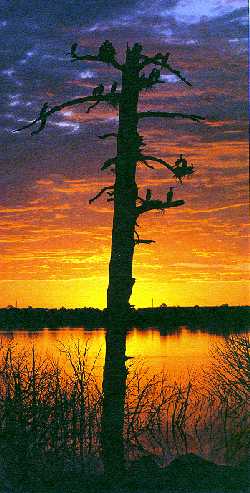Created Wetlands In Northern
Arizona
Response
 Pintail Lake and Redhead Marshes have exceeded the original
objectives and expectations. What started out as a project to favor waterfowl
has developed into a complex of wetland ecosystems with a wide range of
benefits. Similar projects in other areas have been developed as a result of
the success here. Pintail Lake and Redhead Marshes have exceeded the original
objectives and expectations. What started out as a project to favor waterfowl
has developed into a complex of wetland ecosystems with a wide range of
benefits. Similar projects in other areas have been developed as a result of
the success here.
Vegetation
Experience has shown that the
addition of water to these previously arid sites brings on dramatic vegetation
changes. A prime objective has been the establishment of a vigorous vegetative
cover. Cattail, water grass, spike rush, and various sedges have become
established naturally in the created wetlands while others such as hardstem,
softstem, and alkali bulrushes and sego pondweed have been successfully
planted.
Animal
The response of animals to the new
wetlands has been exciting. After 3 years of data collection on Pintail Lake,
L. Piest (1981) stated: "The response of breeding waterfowl has been dramatic.
I estimated that 1,544 ducklings or 76.4 ducklings per hectare (30.93 per
acre), were produced in 1981." The response of other birds has been similar
with the establishment of cormorant and black-crowned night heron rookeries in
the new wetlands.
To date ten bird
species which are classified as endangered, threatened, or sensitive have been
seen using the wetlands. These include the bald eagle, peregrine falcon,
osprey, northern goshawk, snowy egret, belted kingfisher, American avocet, sora
rail, black-crowned night heron, and the double-crested cormorant. Four of
these species (the avocet, sora rail, blackcrowned night heron, and cormorant)
have been found nesting here. A survey done in 1991 to document total bird use
on a weekly basis found 120 different species of birds using the created
wetlands. Some of the birds are predators, feeding on fathead minnows, a small
fish that inhabits part of this wetland system. Other animals found in the
wetlands include rocky mountain elk, mule deer, pronghorn, black bear, coyote,
raccoon, and various kinds of amphibians.
People are also
attracted to these wetlands for a variety of reasons ~ to relax and watch
animals if probably the intent of most people. Facilities were provided to
improve wildlife viewing at Pintail Lake. School groups often use these
wetlands for environmental field trips. The concepts of wastewater cleanup and
recycling have more meaning after experiencing the created wetlands.
Acknowledgments
 Since the first wetland was built at Pintail Lake in 1978 to the
present, the wetlands have been a cooperative effort. The "core team," which
started the project and continues to make it successful today, include the City
of Show Low, the Arizona Game and Fish Department, and the U.S. Forest Service. Since the first wetland was built at Pintail Lake in 1978 to the
present, the wetlands have been a cooperative effort. The "core team," which
started the project and continues to make it successful today, include the City
of Show Low, the Arizona Game and Fish Department, and the U.S. Forest Service.
Other groups have
also played a major role. The U.S. Environmental Protection Agency has provided
guidance and funding for this innovative wastewater treatment project. The
Arizona Department of Environmental Quality is involved in the monitoring and
operational permitting process.
The wetland
project is also supported by the local communities. This includes the local
schools with their field trips. The White Mountain Chapter of the Audubon
Society with the field trips and work projects.
References
. Piest, 1981. "Evaluation of Waterfowl Habitat Improvements on the
Apache/Sitgreaves National Forests, Arizona" USDA/Forest Service. 119pp.
For
more information, please feel free to contact the USDA Forest Service, Lakeside
Ranger District at 520.368.5111 or you may write us at 2022 W. White Mtn.
Blvd., Pinetop-Lakeside, Arizona 85935
White Mountains Online wishes to express
our appreciation to the USDA Forest Service, Lakeside District for providing
this information! This and other articles may be found in print media entitled:
Constructed Wetlands for Wastewater
Treatment and Wildlife Habitat
United States Environmental Protection
Agency
#EPA832-R-93-005
September 1993
Return to: Design & Layout
Return
to: Site Description
Return to:
Background
Return to:Pintail Lake
|

